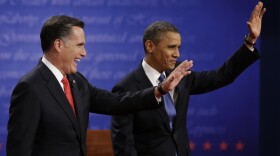Mitt Romney may have seized the advantage in terms of poll numbers and momentum, but there's one area where President Obama enjoys the upper hand.
In the end, it's the only area that counts: the Electoral College. Over the past 20 years, Republicans have had a much lower ceiling when it comes to electoral support, while Democrats have had a significantly higher floor.
"The Democrats start with a larger number of electoral votes in the bank," says Daron Shaw, author of The Race to 270, a book about electoral strategy. That's because while the election is still very much in the air, Obama can count on a larger store of electoral votes that are all but guaranteed to him than Romney can.
Other than Texas, states where Republicans are certain winners, such as Oklahoma, Idaho, Alabama and Alaska, simply don't offer all that many electoral votes. That's why there's been talk all year that Romney has only a "narrow path" to electoral victory, heavily contingent on his carrying Florida and Ohio.
"Really, what it comes down to, the Republicans have to win the battleground states to win the Electoral College," says Lara Brown, a political scientist at Villanova University in Pennsylvania.
GOP consultant Whit Ayres says the "critical swing area" is the Midwest. "Whoever controls that region tends to control the nation right now," he says, "because that region is still competitive for both parties, other than Illinois."
That may be bad news for Romney. States such as Michigan, Wisconsin and Pennsylvania have not supported a GOP presidential nominee since 1988. Still, as Ayres points out, each elected Republicans to statewide office in 2010.
But the industrial states in and around the Midwest serve to illustrate the point: Republicans at the presidential level have not been able to carry enough large states to win any but narrow victories since the 1980s.
George W. Bush hit the GOP's recent high-water mark in 2004 with just 286 electoral votes out of 538. In his 2000 victory, he collected 271 — just one more than the minimum needed to win.
By contrast, Obama and Bill Clinton each won at least 365 electoral votes with their winning campaigns. In each of the five presidential contests dating back to 1992, Democrats have won at least 252 electoral votes.
"There's very little margin for error on the positive side for the Republicans," says Sandy Maisel, a political scientist at Colby College in Maine.
All of this represents a big change from a generation ago. GOP candidates won five of the six presidential contests from 1968 through 1988, twice carrying 49 states along the way. Pundits in those days spoke frequently of a Republican "lock" on the electoral college.
Democrats have since not just picked but blown apart that lock — despite the fact that much recent population growth has been in Republican red states such as Georgia and Texas.
They have managed to make inroads in former GOP strongholds such as the South and the Rocky Mountain West, thanks to the growth of Hispanics, as well as the increasing numbers of educated professionals in suburbs of such states as Colorado and Virginia.
Democrats also have become dominant in the Northeast and along the Pacific Coast.
"The first and most important place to start is California," says Ayres, the GOP consultant.
Republicans used to carry California — back in the days when the party nominated Richard Nixon and Ronald Reagan, both Californians. But Republicans haven't prevailed there since 1988.
Four years ago, the nation's largest state gave Obama 61 percent of its popular vote in 2008 — and its 55 electoral votes.
"Throw in New York and Illinois, where Republicans did well for a very long time, and you have three huge states that have become solidly Democratic," Ayres says.
All of this means that Obama still has the potential to take more than 300 electoral votes. A Romney victory is likely to be narrower, in terms of electoral votes.
But another real possibility is that Romney begins the process of reshaping the map, winning states that haven't gone Republican for a number of years.
"Swing states change," says Shaw, who is also a political scientist at the University of Texas.
Copyright 2020 NPR. To see more, visit https://www.npr.org. 9(MDA3MzEzNjc2MDEzMDI2Mzc4OTc4NTFmNg001))





